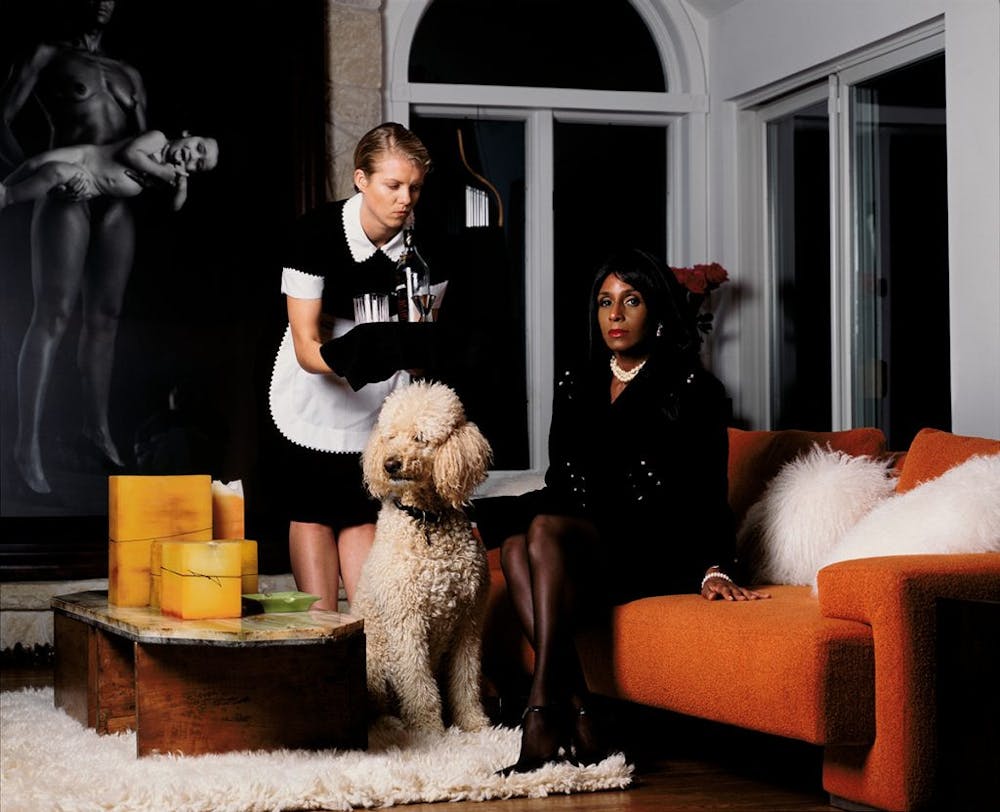“Why are you waiting for the world to validate you?”
In her Oct. 28 lecture hosted by the Nasher Museum, artist Renee Cox reflected on the power this quote had on her. Stuck in a depressive, mid-life slump, she realized that her entire life had been spent wanting to please others and waiting to be praised. This revelation not only taught her how to control her negative thoughts, but served as the inspiration for her collection “The Discreet Charm of the Bougie.”
“The Housewife Missy at Home,” which is currently on display at the Nasher Museum, serves as the introduction into the bold, thought-provoking collection. In the photograph, Cox sits on an orange couch, surrounded by decadent interior design, her Poodle and a white maid. This is the establishment of Missy, the character followed throughout the collection. Cox’s creation came from her desire to craft the antithesis of the stereotypical depressed, emotionally struggling Black women often depicted in the media.
Throughout the series, we see Missy lounging poolside, cigarette in hand, blowing smoke out of her mouth with a sense of melancholy. We see her among school buses, in the supermarket, and even traveling to other countries, with her looking as if her life is crumbling around her. Cox explained that this portrayal of depression in women is often seen solely with white characters. Black women in crisis are often displayed in a derogatory manner, struggling in crack houses and joining the lowest of society. Through this juxtaposition, she rejects this stereotype while also expressing her own emotions.
Cox is no stranger to challenging racism and sexism. She began as a fashion photographer working in New York, a job that left her unhappy after realizing how blissfully ignorant her peers were about racial inequities. Leaving a world where people would rather talk about the divorce of Donald and Ivana Trump than the release of Nelson Mandela, Cox enrolled in the School of Visual Arts to explore her interest in photography. At this time, Cox was also taking on motherhood and exploring a passion for Black history and culture. She decided that the focus of her career would be on changing the stereotypes of Black people and creating “uplifting” art —“taking it to another dimension,” as the artist described it.
In 1994, pregnant with her second child, her work was displayed at the Whitney Museum of Art, making it not only a significant moment in her early career, but also the first time the museum featured a pregnant artist. Though confronted with preexisting notions involving the balance of family and career, Cox knew that she could find fulfillment both with her personal and professional life, rather than having to prioritize just one. That same year, one of her most famous pieces, “Yo Mama,” was released. A celebration of Black motherhood, femininity, and strength, this remains one of her most recognizable pieces.
As her children grew, Cox realized that there was a lack of Black representation in the superhero genre. She decided to create her own Black superhero, a heroine named Raje. Inspired by Wonder Woman’s Black sister, Nubia, Cox poses as the superhero in the streets of New York, sitting on top of the Statue of Liberty, and freeing the caricatures of Aunt Jemima and Uncle Ben from their offensive caricatures in the most recognizable piece from the series, “The Liberation of Aunt Jemima and Uncle Ben.”
Today, after an already fulfilling photography career centered around motherhood, race, and mental health, the artist is planning an exhibition in her current home of the Hamptons with the goal of introducing Black art to the area. While the official lineup of artists has not yet been decided, her current podcast “Ring the Alarm” features many artists who will most likely be included in the exhibit, such as Shinique Smith, Derrick Adams, Sanford Biggers, and more.
At the end of her lecture, Cox reminded the audience: “Don’t make boring shit, there’s already enough boring shit out there!”
“The Housewife Missy at Home” is currently on display at the Nasher Museum as part of “In Relation to Power: Politically Engaged Works from the Collection,” running through February 2022.
Get The Chronicle straight to your inbox
Sign up for our weekly newsletter. Cancel at any time.

